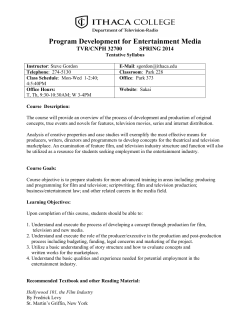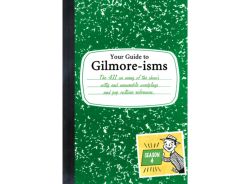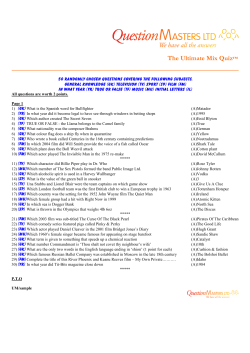
!
Film and Media Theory Kelly Kessler Sample Syllabus kkessle3@depaul.edu !Course Description: This course will serve as a foundation for students in theories of film, television, and new media. An engagement with areas such as formal analysis, television and film spectatorship, authorship, television flow, and media specificity will provide both a brief historical framework for these disciplines, as well as a survey of major texts. Readings will include scholars/theorists such as Sergei Eisenstein, David Bordwell, Laura Mulvey, Horace Newcomb, Ien Ang, Nick Browne, and Henry Jenkins. !Course Goals: After completing this course, you should be able to: • • • • • • • Develop an idea of a trajectory of academic thought regarding theories of film, television, and new media Comprehend, breakdown, and discuss various types of theory and criticism Use media theories to analyze texts Identify and discuss possible shortcomings in utilizations of various theories Discuss contradictions between theories Explore the literature of media theory Produce an original piece of media criticism !Necessary Texts: Film Theory and Criticism by Leo Braudy and Marshall Cohen (7th Edition) Other readings can be found through D2L ! Course Requirements: • Class Participation (10% - 5% reading questions and 5% in-class) • In Class Writing (10% - 2.5x4) • Facilitation of Reading Material (20%) o Outline & Discussion Question (2.5%) o In-Class Facilitation of Readings (7.5%) o Reflection paper (10%) • Take Home Midterm Essay Exam (25%) – Due 10/16 • 15-25 Page Final Paper (35%) o Proposal & Bibliography (5%) – Due 10/9 o Literature Review (5%) – Due 10/23 o Draft – Optional (10%) – Due 11/6 o Final Paper (15% or 25% if no draft turned in) – Due Wednesday November 20 in class (you must come to class) !Assignments: !In-Class Writing: 5 weeks students will be asked to do short in class writing assignments that draw together main concepts from that week’s (or that week’s and a prior week’s) articles. Students will be allowed to use the articles while writing. The function of these assignments is to illustrate comprehension, engage with the concepts, and work on application and synthesis. The lowest grade (or one missed writing) will be dropped. !Facilitation of Reading Materials: On the first day of class, each student will be assigned one of the readings to facilitate. 1. By the Sunday evening before class, s/he will send me an outline of the article, a short description of his or her approach to presenting the articled (which could be the powerpoint the student planned on using), and a minimum of 4 discussion questions s/he will use to guide the class. Discussion questions should be open ended (not yes/no) and encourage discussion and engagement with the text. The description of one’s approach should address any media used, the main points on which s/ he will focus. Remember, the job of the facilitator is NOT to repeat the argument. The job of the facilitator is to engage with and/or challenge the argument. Think about how the article might be useful. How does it apply to other articles read? Is it still relevant in today’s media environment? Specifically address points being made. 2. S/he will come prepared to lead a discussion (20 minutes) on the reading by briefly (no more than 5) setting up the main points and then engaging discussion through his/her prepared questions, use 3. of media, etc. Note: The discussion should move from comprehension to application, critical interrogation, and processing of the ideas. This portion of the grade will be based on the student’s ability to articulate the ideas and encourage the class to participate. (While the presenter cannot wholly be responsible for whether the class participates, the ways in which s/he attempts to encourage such participation will be evaluated.). The discussion may go longer if the class is engaging fully with the materials. Do not just come with a PowerPoint presentation that lists the points of the article one by one. (NOTE: A handout will be posted providing guidelines for presentation on which grades will be based) By the following class period, the student will turn in a 3-4 page reflection paper that does at least one of the following: (a) evaluates the usefulness of the article for possible future use, (b) compares the points of the article to others assigned that week or another, and (c) critiques the effectiveness of arguments made in the article. The student may choose to use a media example (e.g. film, television show, music, ad, etc.) to help in his or her discussion. (NOTE: If this paper is due on a day that something else is due, you can have until that Friday turn in the paper) ! This assignment provides each student valuable experience in planning and facilitating a class activity to extend, explore, and ground the readings in a seminar environment. The student should think about how s/ he can best get the class to delve into the material. Some things to think about: what is the larger application of this article? Do you see any problems with this article? How does it relate to the other articles for the week? Is there a piece of media that can help you discuss this with the class? ! Take Home Midterm Exam: Late Wednesday night students will receive the essay questions (3) via d2l email. Students will have until class the following Wednesday to complete 2 of the 3 essay questions. They may use the materials read in class to answer the questions. Answers to questions must be 4-6 full pages long (each), clearly cite the materials from the readings, make clear and coherent arguments, and be free of errors (both typing and grammatical). Each essay will be graded 80% on content and 20% on writing style. Answers should illustrate an understanding of the materials, an ability to apply them to other materials, and an understanding of how the different concepts relate to each other. !Final Paper: Over the semester each student will research and write a paper (15-25 pages not including bibliography or notes) on a topic of his/her choice. The only real requirement is that the topic be related to media studies and engage on some level with one of the subtopics discussed over the semester. These are broad, so it really opens up the possibilities. Remember, these are ORIGINAL pieces of work. They are not literature reviews. Students should think about what interests them. The paper will be completed in the following manner: a. Proposal and Bibliography: 1-2 page paper that lays out the central question, how the student will go about doing the research, and what he/she thinks he/she will find. A bibliography will include a minimum of 15 academic sources (similar studies, related arguments, theoretical frameworks, etc.) that would be relevant to his/her paper. b. Literature Review/Outline: Each student will write a 5-6 page literature review relevant to his/her topic. The literature review will set up his/her paper and contextualize his/her argument in terms of what has been argued already and the theory that will help support the research paper. A minimum of 7 sources beyond those used in class must be used here. In the final paper, this may take a different form and may be more fully integrated into your larger argument, rather than setting up a contextualization of the topic. Along with this literature review, you must include a 1 page outline reflecting the anticipated structure of your final paper. (On d2l you will find short examples of literature reviews. Also, the Lotz article on Any Day Now includes a nice literature review as she sets up her argument.) The outline will illustrate the tentative structure of your paper. It should be clear what you plan on arguing and how. c. Draft: The draft is optional. If a student chooses to turn one in, it must be a COMPLETE draft, not an outline, incomplete thoughts, un-proofed, etc. If a draft is turned in, I will return complete comments for the student to consider when revising for the final paper. Students must use a minimum of 5 sources, at least 4 of which were not read for class. d. Final Paper: Your final paper will be due during the class meeting finals week. For students who choose NOT to turn in a draft, the final paper will be worth 25% of the overall grade. For those who DID turn in a draft, the draft will be 10% and the final paper 15%. Each student will do a ! short presentation of his/her findings, problems, process. Students must use a minimum of 5 sources, at least 4 of which were not read for class. ! !Week 1 9/11 – !Week 2 9/18 – !Week 3 9/25 – !Week 4 10/2 – Syllabus Film and Realism Readings: Kracauer, “Basic Concepts” (BC) Bazin, “The Ontology of the Photographic Image,” “The Myth of Total Cinema” (BC) Benjamin, “The Work of Art in the Age of its Mechanical Reproduction” (BC) Film Narrative and Form – Classical Hollywood Cinema, Semiotics, Soviet Montage Readings: Bordwell, “Classical Hollywood Cinema: Narrational Principals and Procedures” Thompson, “The Concept of Cinematic Excess” Eisenstein, “Beyond the Shot” and “The Dramaturgy of Film Form” (BC) In-Class Writing #1 Film Authorship – Auteur, Genre, and the Studio System Readings: Wollen, “The Auteur Theory,” (BC) Schatz, “The Whole Equation of Pictures” (BC) Altman, “A Semantic/Syntactic Approach to Film Genre” (BC) Dyer, from Stars (BC) Ideology & Reception in Film Readings: Mulvey, “Visual Pleasures and Narrative Cinema” (BC) Bordwell, “Cognition and Comprehension: Viewing and Forgetting in Mildred Pierce” (BC) Screening: Commolli and Narboni, “Cinema/Ideology/Criticism” (BC) Mildred Pierce (Curtiz, 1945) In-Class Writing #2 Week 5 10/9 – Identity Politics in Television and Film Readings: Weiss, “Queer Feeling When I Look at You” Gray, “Politics of Representation in Network Television” OnL Screen: Beulah, South Central, Ellen In-Class Writing #3 Proposals & Bibliographies Due Week 6 10/16 – !Week 7 10/23 – ! Television Form Readings: Browne, "The Political Economy Of The Television (Super) Text." Barker, "Television Production Techniques as Communication." Caldwell, “Excessive Style: The Crisis in Network Television” Mittell, “Narrative Complexity in Contemporary American Television” OnL Screen: All in the Family, MASH, Buffy the Vampire Slayer Midterm Exam Due in Class – No Late Exams Will Be Accepted Television as a Cultural and Historical Document Readings: McChesney, “Communication for the Hell of It: The Triviality of U.S. Broadcasting History.” Newcomb and Hirsch, “Television as a Cultural Forum” Gitlin, “Prime Time Ideology: The Hegemonic Process in Television Entertainment” Literature Review Due Week 8 10/30 – !Week 9 11/6 – !Week 10 11/13 – Criticism and Television Production Readings: Lotz, “Textual (im)possibilities in the U.S. Post-Network Era: Negotiating Production and Promotion Processes on Lifetime's Any Day Now'” Mann, “It’s Not TV, It’s Brand Management TV: The Collective Author(s) of the Lost Franchise” Rodriguez, “Objectivity and Ethnicity in the Production of Noticiero Univision” OnL Screen: Any Day Now, LOST online videos In-Class Writing #4 Media Reception & Literacy Readings: Ang, “On the Politics of Empirical Audience Research” Fiske, “Moments of television: Neither the text nor the audience” Lewis & Jhally, “The Struggle Over Media Literacy” Hobbs and Jensen, “Past, Present, and Future of Media Literacy” Drafts Due (Optional) Media Convergence Readings: Ross, “Online/Offline: What it Means to Watch (and Make) TV in the Age of the Internet” Jenkins, “Quentin Tarantino’s Star Wars?: Digital Cinema, Media Convergence, and Participatory Culture” Drafts Returned In-Class Writing #5 Finals Week 11/20 – ! (regular classtime) Final Paper Due in Class and Discussion of Findings. Class is Mandatory
© Copyright 2025












